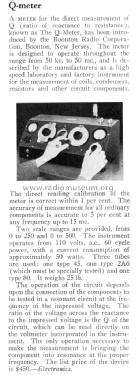Boonton Q-Meter 100-A
Boonton Radio Corp.; Boonton, NJ
- Pays
- Etats-Unis
- Fabricant / Marque
- Boonton Radio Corp.; Boonton, NJ
- Année
- 1935–1941

- Catégorie
- Appareils de mesure et de dépannage (matériel de labo)
- Radiomuseum.org ID
- 219490
Cliquez sur la vignette du schéma pour le demander en tant que document gratuit.
- No. de tubes
- 3
- Principe général
- Appareillage spécial ? Renseignements souhaités SVP.
- Gammes d'ondes
- Bandes en notes
- Tension / type courant
- Alimentation Courant Alternatif (CA) / 110 Volt
- Haut-parleur
- - - Pas de sortie basse fréquence
- Matière
- Boitier métallique
- De Radiomuseum.org
- Modèle: Boonton Q-Meter 100-A - Boonton Radio Corp.; Boonton,
- Forme
- Modèle de table à panneau incliné
- Remarques
- The Boonton Q-Meter Type 100-A covers 50 kc (kHz) to 50 mc (MHz). The direct reading calibration of the meter is correct within 1 %. The accuracy of measurement for all ordinary components is accurate to 5 per cent at any frequency up to 15 mc. Two scale ranges are provided, from 0 to 250 and 0 to 500. The instrument is for 110 volts, 60 cycles, with a current consumption of ca. 50 watts. The model type 100-A is the first Q-Meter at all and the first instrument of Boonton Radio Corp. The market introduction was May 1935 (see article in "Electronics". Q-meters measure the quality factor of coils and other components used in electronic devices and had broad applications in the testing of components and systems.
Direct successor is the Boonton Q-Meter 160-A - with its "syster model" 170-A. See Boonton "The Notebook".
Boonton, New Jersey-based Boonton Radio Corporation was founded in 1934 by W. D. Loughlin and several associates and was a manufacturer of electronic test instruments. The new firm concentrated its engineering skill on creating new measuring equipment for the still-young radio industry.
HP acquired Boonton in 1959 as a wholly-owned subsidiary. By then the firm had 150 employees and was a pioneer maker of precision instruments for measuring electrical circuit quality and checking aircraft guidance systems. In a year of phenomenal growth for HP (the company acquired three other firms in 1959), Boonton added to the HP family an old, well-established company with an excellent reputation in a field closely related to many HP products.
- Poids net
- 25 lb (25 lb 0 oz) / 11.350 kg
- Prix de mise sur le marché
- 450.00 $
- Auteur
- Modèle crée par Ernst Erb. Voir les propositions de modification pour les contributeurs supplémentaires.
- D'autres Modèles
-
Vous pourrez trouver sous ce lien 20 modèles d'appareils, 19 avec des images et 10 avec des schémas.
Tous les appareils de Boonton Radio Corp.; Boonton, NJ
Contributions du forum pour ce modèle: Boonton Radio Corp.;: Boonton Q-Meter 100-A
Discussions: 1 | Publications: 1
There is a good article (PDF) by Henry P. Hall with the title: A History of Impedance Measurements":
ietlabs.com/pdf/GenRad_History/A_History_of_Z_Measurement.pdf
It begins with the early experimenters from 1775 to 1915, follows with the first commercial instruments 1900 to 1945, where in 2.5 can be found the following:
"Other Early Ac Instruments: Perhaps the most famous RF measuring instrument was the Boonton Radio Company's Type 100A "Q Meter" designed by C.J. Franks and W.D. Loughlin and introduced in 1934.
This popular instrument went through many revisions over the years with the BRC types 160-A appearing in 1939 (see figure 2-36) and 260-A in 1953 being the best known. Hewlett-Packard, who bought BRC, listed the type 4342A Q meter in its catalogs through 1993. In this circuit the unknown inductor is resonated against a variable capacitor whose dial reads inductance directly at certain frequencies and the inductor's Q value is proportional to the resonant peak voltage and is read on the scale of a vacuum-tube voltmeter."
You find this on page 25. The design was in 1934, but the first ad seems to appear May 1935. We believe this was the market introduction. Here you also find that the market introduction of the follower, the Type 160-A, was in 1939 but it could have been the design and introduction was later.
We would be thankful if you could send us some examples of ads or other information about the introduction but also about the follower instruments. We should be able to slowly get proofs by primary sources for such dates - including the end of a production - which can be seen in catalogs.
As a guest you can use the contact form. Thank you.
Ernst Erb, 28.May.12


